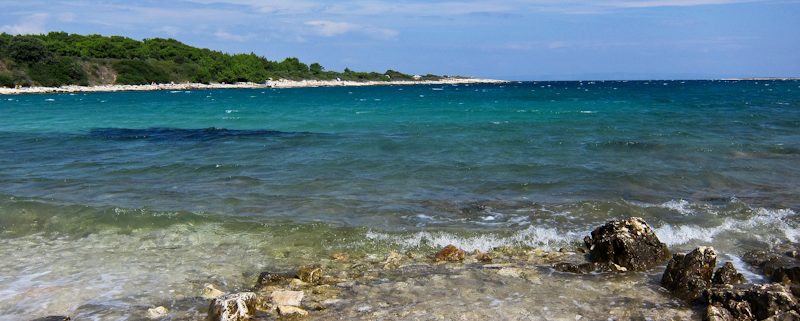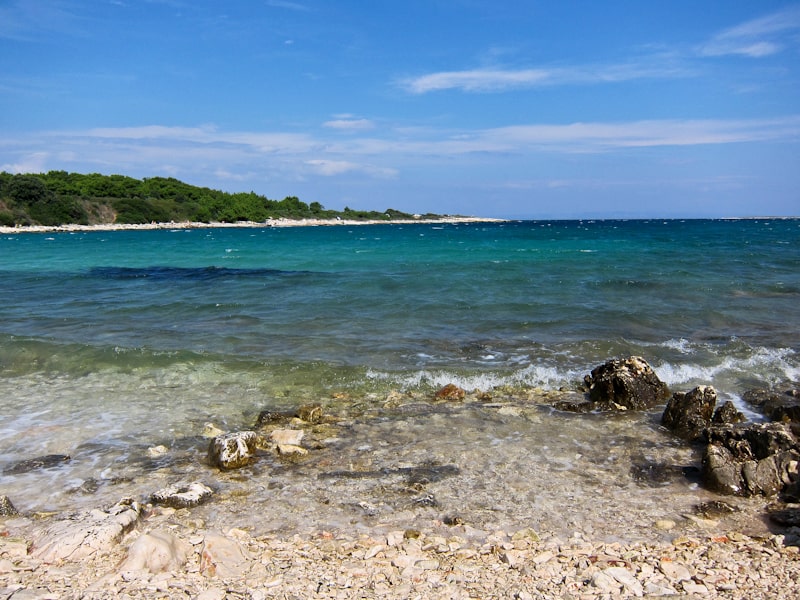
With over 1,000 kilometres of coastline, it is no wonder that there’s many, many beaches in Croatia! In fact, one of the wonderful things about the coastline is that almost any little space alongside the sea is suitable for bathing, swimming and relaxing on, no matter how small.
Some of the beauty of Croatia’s beaches can also be found in their surroundings – adjacent to crops of trees or vegetation, close to picturesque harbours, or overlooked by stunning scenery means being on a Croatian beach is a great experience.
One of the main things to point out is that the vast majority of beaches in Croatia are pebble beaches. There are some sandy beaches in the country, but these are few and far between – and also tend to get very busy during high season because many visitors seem to clamour for sandy beaches.
Of course, pebble beaches are no bad thing. The lack of sand means that the waters are often considerably clearer, which adds to the beauty of the Adriatic. One tip, however – make sure you either wear flip flops to the beach (and walk with them to the edge of the water, before wading/diving in) or buy or bring along a pair of water shoes.
This latter tip may be especially suitable for children, who might find it harder to walk on the pebbles. Water shoes will also help if you’ve been a bit more adventurous and have stumbled across a rocky little cove or similar.

Back in the “old days”, hotels in Croatia would often claim to have their own beach. More often than not, this constituted a bit of concrete from which you could dive off into the sea. Whilst this undoubtedly provided great, direct access to the sea, it was hardly the kind of place to laze around all day.
If your hotel doesn’t quite have the beach facilities you were after – and this is true for whatever kind of accommodation you stay in – DO check out other beaches in the town/resort, don’t just frequent the nearest. DO also feel free to ask your accommodation host about tips on good local beaches. Finally, DO also consider taking a day trip to a local island (if possible) to find a beach with a change of pace or scene (e.g. Lokrum island or the Elafiti islands for Dubrovnik; Sveti Nikola for Porec; even the larger islands in Dalmatia for resorts there).
Rough Guides came up with a useful list of The 10 Best Beaches in Croatia – take a look to see if your favourite is in there, or to read up on some new places to explore.
Beaches in Croatia – Water Quality
Croatia’s beaches and its water, overall, are very well kept, maintained and monitored. The Blue Flag programme, which awards a prestigious blue flag for one year at a time to beaches and marinas that meet certain requirements (water quality, environmental management, safety, services provided), has regularly awarded a great number of Croatia’s beaches with a flag – these are proudly hoisted up before the start of each summer season.
For the 2022 season, 70 beaches were awarded a Blue Flag alongside 30 of Croatia’s marinas. You can search for the full list on the Blue Flag website which gives useful information about all the beaches. More information can also be found on the website of the Croatian Blue Flag representative organisation – named Lijepa Nasa – although it is in Croatian only.
Another very useful online tool is the Ministry of Environmental Protection, Physical Planning and Construction’s (phew – that’s a long name!) sea bathing water quality webpage. You will see that the water at the vast majority of the 1000+ beaches is rated excellent; a handful as good; very few as sufficient; and in fact NO beaches are rated poor. Use the website to search for beaches; the site also has helpful photos of beaches and their facilities/surroundings, so you can get a feel for each.
The European Environmental Agency also monitors water quality; in 2021, 99.2% of sites in Croatia were deemed “excellent” – the highest figure for the whole European Union! In 2022, 98.9% of sites in Croatia were rated as excellent; a slight fall, yes, but Croatia still topped the table for water quality in the European Union.
- Take a look at our Famous Beaches in Croatia page!
